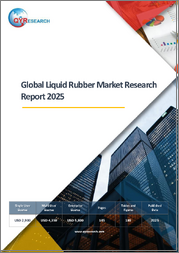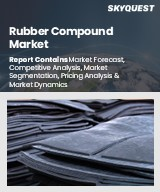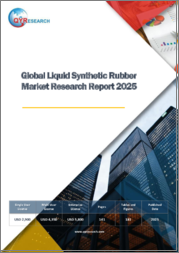
|
시장보고서
상품코드
1504231
합성고무 시장 규모, 점유율, 예측 및 동향 분석 : 유형별, 용도별, 산업별 - 세계 예측(-2031년)Synthetic Rubber Market Size, Share, Forecast, & Trends Analysis by Type (SBR, EPDM, BR, SBC, IIR, NBR, IR, CR), Application (Tires, Textiles & Apparel, Electronic, Packaging), Industry (Construction, Automotive, Industrial) - Global Forecast to 2031 |
||||||
합성고무 시장은 2024-2031년간 4.4%의 연평균 복합 성장률(CAGR)로 성장하여 2031년에는 423억 달러에 달할 것으로 예상됩니다. 이 시장의 성장은 건설 활동 및 인프라 개발 증가, 자동차 생산 및 판매 증가, 제조, 기계 및 장비와 같은 산업 분야의 성장에 기인합니다. 또한, 친환경 합성고무 대체품에 대한 수요 증가도 시장 성장 기회를 창출할 것으로 예상됩니다. 그러나 폐기물 처리, 오염 및 탄소 배출 문제는 이 시장의 성장을 저해할 수 있습니다. 또한, 정부의 엄격한 환경 규제, 품질 기준 및 규정 준수 정책은 이 시장에서 사업을 운영하는 기업에게 큰 도전이 될 것입니다.
이 조사 보고서는 주요 5개 지역의 합성고무 시장을 상세하게 분석하여 현재 시장 동향, 시장 규모, 시장 점유율, 최근 동향, 2031년까지의 예측을 수록했습니다.
목차
제1장 서론
제2장 조사 방법
제3장 주요 요약
제4장 시장 인사이트
- 개요
- 성장 촉진요인
- 성장 억제요인
- 기회
- 과제
- 동향
제5장 합성고무 시장 : 유형별 평가
- 개요
- Styrene Butadiene Rubber (SBR)
- Polybutadiene Rubber (BR)
- Styrene Block Copolymer (SBC)
- Ethylene Propylene Diene Rubber (EPDM)
- Butyl Rubber (IIR)
- Acrylonitrile-butadiene Rubber (NBR)
- Isoprene Rubber (IR)
- Chloroprene Rubber (CR)
- 기타 유형
제6장 합성고무 시장 : 용도별 평가
- 개요
- 타이어
- 자동차(비타이어)
- 신발 컴포넌트
- 섬유 및 의류
- 씰 및 개스킷
- 호스 및 벨트
- 전자기기
- 윤활유
- 포장
- 기타 용도
제7장 합성고무 시장 : 최종 이용 산업별 평가
- 개요
- 건설
- 자동차
- 산업용 제조
- 신발
- 항공우주
- 가전
- 기타 최종 이용 산업
제8장 합성고무 시장 : 지역별 평가
- 개요
- 북미
- 미국
- 캐나다
- 유럽
- 독일
- 영국
- 프랑스
- 이탈리아
- 스페인
- 러시아
- 네덜란드
- 기타 유럽
- 아시아태평양
- 중국
- 일본
- 인도
- 한국
- 태국
- 싱가포르
- 기타 아시아태평양
- 라틴아메리카
- 브라질
- 멕시코
- 아르헨티나
- 기타 라틴아메리카
- 중동 및 아프리카
- 아랍에미리트(UAE)
- 사우디아라비아
- 남아프리카공화국
- 기타 중동 및 아프리카
제9장 세계의 합성고무 시장 경쟁 분석
- 개요
- 주요 성장 전략
- 경쟁 벤치마킹
- 경쟁 대시보드
- 업계 리더
- 시장 차별화 요인
- 전위 기업
- 신규 기업
- 시장 점유율 분석
제10장 기업 개요(기업 개요, 재무 개요, 제품 포트폴리오, 최근 동향)
- China Petrochemical Corporation(A Subsidiary of Sinopec Corp.)
- ERIKS N.V.
- The Dow Chemical Company
- Exxon Mobil Corporation
- Kumho Petrochemical Co., Ltd.(KKPC)
- Zeon Corporation
- Nizhnekamskneftekhim(NKNK)
- Mitsui Chemicals, Inc.
- JSR Corporation
- SABIC
- Denka Company Limited
- Asahi Kasei Corporation
- Indian Synthetic Rubber Private Limited
- Apcotex
- Reliance Industries Limited
- Trinseo PLC
- TSRC Corporation
- Michelin Group
- LANXESS
(주 : 주요 5개사의 SWOT 분석을 제공합니다.)
제11장 부록
LSH 24.07.10Synthetic Rubber Market Size, Share, Forecast, & Trends Analysis by Type (SBR, EPDM, BR, SBC, IIR, NBR, IR, CR), Application (Tires, Textiles & Apparel, Electronic, Packaging), Industry (Construction, Automotive, Industrial)-Global Forecast to 2031
The research report titled, 'Synthetic Rubber Market Size, Share, Forecast, & Trends Analysis by Type (SBR, EPDM, BR, SBC, IIR, NBR, IR, CR), Application (Tires, Textiles & Apparel, Electronic, Packaging), Industry (Construction, Automotive, Industrial)-Global Forecast to 2031', provides in-depth analysis of the synthetic rubber market across five major geographies and emphasizes on the current market trends, market sizes, market shares, recent developments, and forecasts till 2031.
The synthetic rubber market is projected to reach $42.3 billion by 2031, at a CAGR of 4.4% from 2024 to 2031. The growth of this market is driven by increasing construction activities and infrastructure development, increasing vehicle production and sales, and growth in industrial sectors, including manufacturing, machinery, and equipment. Additionally, the growing demand for eco-friendly synthetic rubber alternatives is expected to create market growth opportunities. However, issues related to waste disposal, pollution, and carbon emissions may restrain the growth of this market. Moreover, stringent environmental regulations, quality standards, and compliance policies by governments pose a major challenge for the players operating in this market.
The synthetic rubber market is segmented by type, application, and end-use industry. The study also evaluates end-user industry competitors and analyzes the market at the regional and country levels.
Based on type, the synthetic rubber market is broadly segmented into styrene butadiene rubber (SBR), polybutadiene rubber (BR), styrene block copolymer (SBC), ethylene propylene diene rubber (EPDM), butyl rubber (IIR), acrylonitrile-butadiene rubber (NBR), isoprene rubber (IR), chloroprene rubber (CR), and other types. In 2024, the styrene butadiene rubber (SBR) segment is expected to account for the largest share of above 29.0% of the synthetic rubber market. The large market share of this segment can be attributed to the increasing demand for tires, the growing use of SBR in tire manufacturing due to its high abrasion resistance and good aging properties, and the growing shift toward green tire technologies that incorporate higher proportions of bio-based and recycled materials including SBR.
However, the ethylene propylene diene rubber (EPDM) segment is projected to witness the highest growth rate during the forecast period of 2024-2031. This growth is driven by the increasing use of EPDM in construction applications, automotive seals, gaskets, weatherstripping, and hoses due to its high weather resistance and durability; growing focus on renewable energy sources as EPDM is used in seals & gaskets for renewable energy technologies.
Based on application, the synthetic rubber market is broadly segmented into tires, automotive (non-tire), footwear components, textiles & apparel, seals & gaskets, hoses & belts, electronic devices, lubrications, packaging, and other applications. In 2024, the tires segment is expected to account for the largest share of above 72.0% of the synthetic rubber market. The large market share of this segment is attributed to the expansion of the automotive industry, driven by increasing vehicle production and sales globally, increasing vehicle maintenance, rising demand for tires, and growing need for tire replacement due to wear and tear.
However, the electronic devices segment is projected to witness the highest growth rate during the forecast period of 2024-2031. This growth is driven by the rise in the consumer electronics market, the growing popularity of wearable devices such as smartwatches, fitness trackers, and earbuds, the expansion of telecommunication infrastructure, including the deployment of 5G networks and increased connectivity, and the increasing use of synthetic rubber in various electronic components, such as keypads, gaskets, vibration dampening materials, and seals.
Based on end-use industry, the synthetic rubber market is broadly segmented into construction, automotive, industrial manufacturing, footwear, aerospace, consumer electronics, and other end-use Industries. In 2024, the automotive segment is expected to account for the largest share of above 76.0% of the synthetic rubber market. The large market share of this segment can be attributed to the growth of the automotive industry, the increasing use of synthetic rubber in automotive applications, such as tires, seals, gaskets, automotive interiors, exteriors, and chassis systems, and increasing demand for high-performance synthetic rubber materials with enhanced properties.
However, the consumer electronics segment is projected to witness the highest growth rate during the forecast period of 2024-2031. This growth is driven by constant technological advancements in the consumer electronics industry, the growing popularity of wearable devices, the expansion of telecommunication infrastructure, the growing demand for water and dust-resistant devices, and the proliferation of IoT devices, including smart home appliances, connected wearables, and industrial sensors.
Based on geography, the synthetic rubber market is segmented into North America, Europe, Asia-Pacific, Latin America, and the Middle East & Africa. In 2024, Asia-Pacific is expected to account for the largest share of above 54.0% of the synthetic rubber market, followed by Europe, North America, Latin America, and the Middle East & Africa. The region is projected to register the highest CAGR of 6.0% during the forecast period. The large market share of Asia-Pacific is mainly attributed to the increasing demand for synthetic rubber in various industries, including automotive, construction, manufacturing, and consumer goods, increasing urbanization and infrastructure development, increasing government initiatives and policies promoting industrial growth, and growing automotive and consumer electronics industry in countries including China, Japan, South Korea, and India.
Key Players:
The key players operating in the synthetic rubber market are China Petrochemical Corporation (a subsidiary of Sinopec Corp.) (China), ERIKS N.V.(Netherlands), The Dow Chemical Company (U.S), Exxon Mobil Corporation (U.S.), Kumho Petrochemical Co., Ltd. (KKPC) (South Korea), Zeon Corporation (Japan), Nizhnekamskneftekhim (Russian), Mitsui Chemicals, Inc. (Japan), JSR Corporation (Japan), SABIC (Saudi Arabia), Denka Company Limited (Japan), Asahi Kasei Corporation (Japan), Indian Synthetic Rubber Private Limited (India), Apcotex (India), Reliance Industries Limited (India), Trinseo PLC (U.S.), TSRC Corporation (Taiwan), Michelin Group (France), and LANXESS (Germany).
Key questions answered in the report-
- Which are the high-growth market segments based on type, application, end-use industry, and geography?
- What was the historical market for the synthetic rubber market?
- What are the market forecasts and estimates for the period 2024-2031?
- What are the major drivers, restraints, opportunities, and challenges in the synthetic rubber market?
- Who are the major players, and what shares do they hold in the synthetic rubber market?
- What is the competitive landscape like in the synthetic rubber market?
- What are the recent developments in the synthetic rubber market?
- What are the different strategies adopted by the major players in the synthetic rubber market?
- What are the key geographic trends, and which are the high-growth countries?
- Who are the local emerging players in the synthetic rubber market, and how do they compete with the other players?
Scope of the report:
Synthetic Rubber Market Assessment-by Type
- Styrene Butadiene Rubber (SBR)
- Polybutadiene Rubber (BR)
- Styrene Block Copolymer (SBC)
- Ethylene Propylene Diene Rubber (EPDM)
- Butyl Rubber (IIR)
- Acrylonitrile-butadiene Rubber (NBR)
- Isoprene Rubber (IR)
- Chloroprene Rubber (CR)
- Other Types
Synthetic Rubber Market Assessment-by Application
- Tires
- Automotive (Non-tire)
- Footwear Components
- Textiles & Apparel
- Seals & Gaskets
- Hoses & Belts
- Electronic Devices
- Lubrications
- Packaging
- Other Applications
Synthetic Rubber Market Assessment-by End-use Industry
- Construction
- Automotive
- Industrial Manufacturing
- Footwear
- Aerospace
- Consumer Electronics
- Other End-use Industries
Synthetic Rubber Market Assessment-by Geography
- North America
- U.S.
- Canada
- Europe
- Germany
- U.K.
- France
- Italy
- Spain
- Russia
- Netherlands
- Rest of Europe
- Asia-Pacific
- China
- Japan
- India
- South Korea
- Thailand
- Singapore
- Rest of Asia-Pacific
- Latin America
- Mexico
- Brazil
- Argentina
- Rest of Latin America
- Middle East & Africa
- South Africa
- UAE
- Saudi Arabia
- Rest of the Middle East & Africa
TABLE OF CONTENTS
1. Introduction
- 1.1. Market Definition & Scope
- 1.2. Market Ecosystem
- 1.3. Currency & Limitations
- 1.4. Key Stakeholders
2. Research Methodology
- 2.1. Research Approach
- 2.2. Data Collection & Validation
- 2.2.1. Secondary Research
- 2.2.2. Primary Research
- 2.3. Market Assessment
- 2.3.1. Market Size Estimation
- 2.3.2. Bottom-up Approach
- 2.3.3. Top-down Approach
- 2.3.4. Growth Forecast
- 2.4. Assumptions for the Study
3. Executive Summary
- 3.1 Market Overview
- 3.2 Market Analysis, by Type
- 3.3 Market Analysis, by Application
- 3.4 Market Analysis, by End-use Industry
- 3.5 Market Analysis, by Geography
- 3.6 Competitive Analysis
4. Market Insights
- 4.1 Overview
- 4.2 Factors Affecting Market Growth
- 4.2.1 Drivers
- 4.2.1.1 Increasing Construction Activities and Infrastructure Development
- 4.2.1.2 Increasing Vehicle Production and Sales
- 4.2.1.3 Growth In Industrial Sectors Including Manufacturing, Machinery, and Equipment
- 4.2.2 Restraint
- 4.2.2.1 Issues Related to Waste Disposal, Pollution, and Carbon Emissions
- 4.2.3 Opportunity
- 4.2.3.1 Growing Demand for Eco-friendly Synthetic Rubber Alternatives
- 4.2.4 Challenge
- 4.2.4.1 Stringent Environmental Regulations, Quality Standards, and Compliance Policies by Governments
- 4.2.5 Trend
- 4.2.5.1 Increasing Demand for High-performance Synthetic Rubber Materials
- 4.2.1 Drivers
5. Synthetic Rubber Market Assessment-by Type
- 5.1 Overview
- 5.2 Styrene Butadiene Rubber (SBR)
- 5.3 Polybutadiene Rubber (BR)
- 5.4 Styrene Block Copolymer (SBC)
- 5.5 Ethylene Propylene Diene Rubber (EPDM)
- 5.6 Butyl Rubber (IIR)
- 5.7 Acrylonitrile-butadiene Rubber (NBR)
- 5.8 Isoprene Rubber (IR)
- 5.9 Chloroprene Rubber (CR)
- 5.10 Other Types
6. Synthetic Rubber Market Assessment-by Application
- 6.1 Overview
- 6.2 Tires
- 6.3 Automotive (Non-tire)
- 6.4 Footwear Components
- 6.5 Textiles & Apparel
- 6.6 Seals & Gaskets
- 6.7 Hoses & Belts
- 6.8 Electronic Devices
- 6.9 Lubrications
- 6.1 Packaging
- 6.11 Other Applications
7. Synthetic Rubber Market Assessment-by End-use Industry
- 7.1 Overview
- 7.2 Construction
- 7.3 Automotive
- 7.4 Industrial Manufacturing
- 7.5 Footwear
- 7.6 Aerospace
- 7.7 Consumer Electronics
- 7.8 Other End-use Industries
8. Synthetic Rubber Market Assessment-by Geography
- 8.1 Overview
- 8.2 North America
- 8.2.1 U.S.
- 8.2.2 Canada
- 8.3 Europe
- 8.3.1 Germany
- 8.3.2 U.K.
- 8.3.3 France
- 8.3.4 Italy
- 8.3.5 Spain
- 8.3.6 Russia
- 8.3.7 Netherlands
- 8.3.8 Rest of Europe
- 8.4 Asia-Pacific
- 8.4.1 China
- 8.4.2 Japan
- 8.4.3 India
- 8.4.4 South Korea
- 8.4.5 Thailand
- 8.4.6 Singapore
- 8.4.7 Rest of Asia-Pacific
- 8.5 Latin America
- 8.5.1 Brazil
- 8.5.2 Mexico
- 8.5.3 Argentina
- 8.5.4 Rest of Latin America
- 8.6 Middle East & Africa
- 8.6.1 UAE
- 8.6.2 Saudi Arabia
- 8.6.3 South Africa
- 8.6.4 Rest of Middle East & Africa
9. Global Synthetic Rubber Market Assessment - Competitive Analysis
- 9.1. Overview
- 9.2. Key Growth Strategies
- 9.3. Competitive Benchmarking
- 9.4. Competitive Dashboard
- 9.4.1. Industry Leaders
- 9.4.2 Market differentiators
- 9.4.3 Vanguards
- 9.4.4 Emerging Companies
- 9.5. Market Share Analysis
10. Company Profiles (Company Overview, Financial Overview, Product Portfolio, and Recent Developments)
- 10.1 China Petrochemical Corporation (A Subsidiary of Sinopec Corp.)
- 10.2 ERIKS N.V.
- 10.3 The Dow Chemical Company
- 10.4 Exxon Mobil Corporation
- 10.5 Kumho Petrochemical Co., Ltd. (KKPC)
- 10.6 Zeon Corporation
- 10.7 Nizhnekamskneftekhim (NKNK)
- 10.8 Mitsui Chemicals, Inc.
- 10.9 JSR Corporation
- 10.10 SABIC
- 10.11 Denka Company Limited
- 10.12 Asahi Kasei Corporation
- 10.13 Indian Synthetic Rubber Private Limited
- 10.14 Apcotex
- 10.15 Reliance Industries Limited
- 10.16 Trinseo PLC
- 10.17 TSRC Corporation
- 10.18 Michelin Group
- 10.19 LANXESS
(Note: SWOT Analysis of the Top 5 Companies will be Provided)
11. Appendix
- 11.1 Available Customization
- 11.2 Related Reports



















